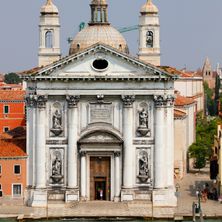

Also known as the Gesuati, the Church of St Mary of the Rosary is a fine example of Venetian Rococo architecture. It was built in the second quarter of the 18th century for the Dominican order, which acquired the land from an order that originally occupied the territory, the Jesuati. The Jesuati were founded in Siena in the 14th century by Giovanni Colombini. Colombini was a wealthy merchant who abandoned his family and riches and devoted himself to a life of apostolic poverty, community service and preaching. At the beginning and end of each sermon he would loudly call out the name Jesus, which is how his order got its name.
It is important not to confuse the Jesuati with the Jesuits, which was a much bigger order and played a more important role in European society. In the 15th century the Jesuati obtained a monopoly from the Venetian government on the distillation of wine and built a small church next to the place on which would later stand the Church of St Mary of the Rosary. By the 17th century the Jesuati order was losing members and popularity and was eventually suppressed by Pope Clement 9th in 1668. Their property was auctioned off and bought by the Dominicans, who went on to construct the new church.
It was architect Giorgio Massari who was chosen to build this new shrine. He based his design on the works of Andrea Palladio, especially the façade, which echoes the rigid symmetry of Palladio's Church of the Redeemer and Church of San Giorgio Maggiore on the other side of the canal. The façade contains four statues representing the four cardinal virtues: Prudence, Justice, Fortitude and Temperance. Massari was also responsible for the interior decoration and for commissioning the paintings and sculptures. For this he turned to the leading artists of the epoch.
The ceiling frescoes are the work of Giambattista Tiepolo: the central one represents the Institution of the Rosary, the one nearest to the entrance is the Glory of St Dominic and the one nearest to the altar is the Appearance of the Virgin to St Dominic. No painter captured the lightness and joy of 18th century Venice better than Tiepolo. Looking at his azure colors, we sometimes get the feeling that we are looking at the sky itself. Other works by Tiepolo can be found by the first altar on the right - the Madonna with three Dominican female saints, and on the ceiling behind the main altar - David playing the harp.
Another representative painter of the era was Giambattista Piazzetta, whose somber painting of three male Dominican saints hangs above the third altar on the right. There is also a very significant work, in the historical sense, which is located above the first altar on the left. It belongs to the elegant brush of Sebastiano Ricci and depicts the three most famous Dominicans: Thomas Acquinas, who wrote the monumental theological treatise 'Summa Theologica', St Peter Martyr, who fervently preached against heresy; and Pope Pious 5th, who spearheaded the Counter Reformation.
Slightly out of era, but not entirely out of context, is Tintoretto's Crucifixion, which hangs above the third altar on the left.
Most of the sculptures in the shrine were executed by the leading Rococo sculptor of the day, Giovan Maria Morlaiter. His most outstanding works for the church include: the Patriarch Abraham, in the first right niche; the Prophet Aaron, in the second right niche; St Paul, in the third right niche; King Melchisedek, in the first left niche; the Prophet Moses, in the second left niche; and St Peter, in the third left niche.